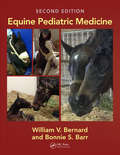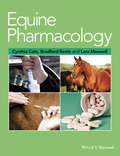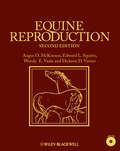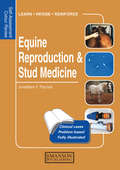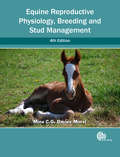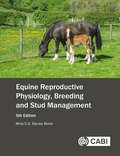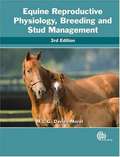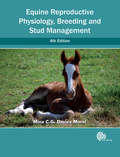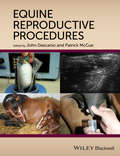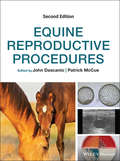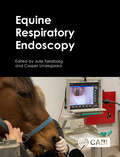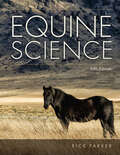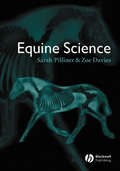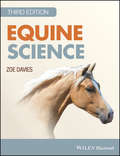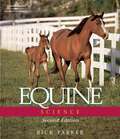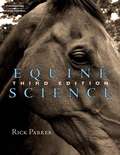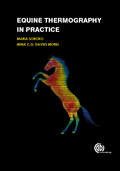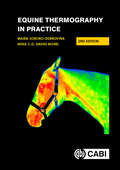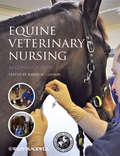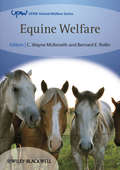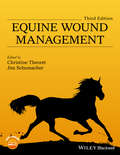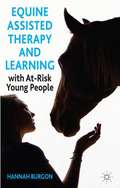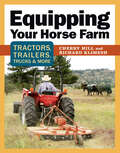- Table View
- List View
Equine Pediatric Medicine (Manson Ser.)
by William Bernard Bonnie BarrKey features New chapter on nutrition Includes new section of case studies Completely revised and updated chapters throughout This systematic yet concise guide to equine pediatric medicine covers etiology, pathophysiology, clinical presentation, differential diagnosis, diagnosis, and management. Beginning with a thorough explanation of the physical examination, the chapters then take the reader through the different disorders associated with each body system, including liver, cardiovascular, respiratory, opthalmologic, endocrine, and muscoskeletal diseases. A brand new chapter on nutrition has been added to this fully revised text. The book is superbly illustrated throughout with photographs, diagrams, radiographs and tables, while a new section of in-depth case studies brings the information to life and is ideal for students. Equine practitioners will value this as a ready reference, while veterinary students and technicians can use it as a complete guide to equine pediatric disease.
Equine Pharmacology
by Bradford Bentz Cynthia Cole Lara MaxwellEquine Pharmacology combines highly practical therapeutic guidance with reliable scientific background information to provide a clinically relevant resource. Taking a body systems approach to the subject, the book offers the equine clinician fast access to drug options for a given disease, with additional information available for reference as needed. Logically organized to lead the reader through the clinical decision-making process, Equine Pharmacology is a user-friendly reference for pharmacological information on the horse.The book begins with a general review section presenting the principles of antimicrobials, anesthesia, analgesics, anti-parasitics, foals, fluid therapy, and drug and medication control programs. The remainder of the book is devoted to a body systems approach to therapeutics, allowing the reader to search by affected system or specific disease to find detailed advice on drug therapy. Equine Pharmacology is an invaluable addition to the practice library for any clinician treating equine patients.
Equine Reproduction
by Edward L. Squires Wendy E. Vaala Angus O. Mckinnon Dickson D. VarnerNow in a much-anticipated two-volume new edition, this gold-standard reference stands as the most comprehensive and authoritative text on equine reproduction. Serving theriogenologists, practitioners and breeders worldwide as a one-stop resource for the reproductive assessment and management of equine patients, Equine Reproduction, Second Edition provides detailed information on examination techniques, breeding procedures, pregnancy diagnosis and management, reproductive tract diseases and surgery, and foaling. A companion CD offers hundreds of images from the book in color. For the Second Edition, the stallion, mare and foal sections have been thoroughly updated and revised to include the latest information on every subject. New topics include discussion of nutritional and behavioral factors in the broodmare and stallion, parentage testing, fetal sexing and the health and management of older foals, weanlings and yearlings. Additionally, this outstanding Second Edition features a new section on assisted reproductive techniques, including detailed information on artificial insemination, in-vitro fertilization, embryo transfer and technology.
Equine Reproduction & Stud Medicine: Self-Assessment Color Review (Veterinary Self-Assessment Color Review Series)
by Jonathan PycockInvolvement with equine reproduction is very common for the veterinarian in practice, and there is enormous demand for continuing education, particularly in the light of recent changes in science and practice, such as the routine use of ultrasound, improved standards of foal care, and the importance of artificial insemination.The 22 contributing au
Equine Reproductive Physiology, Breeding and Stud Management
by Mina Davies MorelFully updated and revised, the fourth edition of this popular textbook provides a complete and comprehensive account of how to successfully breed horses. Beginning with a grounding in reproductive anatomy, it reviews endocrine control and selection for breeding mares and stallions, pregnancy, parturition and lactation.
Equine Reproductive Physiology, Breeding and Stud Management (Cabi Publishing Ser.)
by Mina C Davies MorelEquine Reproductive Physiology Breeding and Stud Management, 5th Edition provides a thorough grounding in equine reproductive anatomy and physiology for equine, animal and veterinary science students. Including all aspects of breeding and stud management, it contains detailed coverage on the management of mares, stallions and foals, as well as stud management practicalities such as infertility, artificial insemination and advanced reproductive techniques. This new edition provides: - Practical, stud management applications underpinned by scientific research; - New material on techniques and advances such as in vitro embryo production, cloning, transgenics and DNA technology; - Increased pedagogic features such as video links, glossary, review questions, and a new internal design. Updated throughout with new references, this textbook continues to provide an authoritative treatise of equine reproduction for students, practising veterinary surgeons and stud managers.
Equine Reproductive Physiology, Breeding and Stud Management, 3rd Edition
by Mina Davies MorelThis third edition of the highly successful textbook is updated throughout and printed in two colours in a new larger format. Coverage includes the reproductive anatomy, endocrine control and selection for breeding of both the mare and stallion, and also pregnancy, parturition and lactation in the mare. This comprehensive text goes on to study how this knowledge can be applied to the successful breeding of horses, maximizing both productivity and animal welfare. It has also been expanded to include more recent experimental work and updated references, including a brand new chapter on the significant developments in embryo technology. This widely popular textbook is an essential addition to the collections of both students in equine science and practising veterinarians. " Extensively illustrated with over 240 diagrams and photographs " New larger format printed in two colours throughout " New coverage of developments in embryo technology " Updated references Readership: HND, degree and post graduate courses in Equine science/studies; veterinary science students, stud managers/practitioners Quotes about the prev. editions: "This book is a proven success as a textbook for degree and diploma courses in equine studies. It also has proved to be a useful supplementary text for veterinary students, as well as valuable for veterinary practitioners and stud managers" - Journal of Equine Veterinary Science "A very useful book for veterinary students, veterinarians, reproductive physiologists and farm managers" - Animal Welfare "The book is packed with practical information that is well organised and is presented in a readily available format" - G. W. C. England "This book is ideal for its targeted readers and for anyone wanting to know and understand the why and how of running a horse or pony breeding enterprise. ...an excellent handy reference for the practise shelf" - D. M. Carson, The Veterinary Record "This book is for the breeder or hairy ponies and for the student of equine science alike" - M. E. Mcgillivary, The Ark "...this textbook will be useful for both horse owners and veterinarians" - R. M. Löfstedt, Canadian Veterinary Journal
Equine Reproductive Physiology, Breeding and Stud Management, 4th Edition
by Mina Davies MorelThe fourth edition of this popular textbook provides a comprehensive account of how to successfully breed horses. Updated throughout, the new edition will cover techniques such as cloning, intra-cytoplasmic sperm injections (ICSI), in vitro fertilisation (IVF) and related reproductive technology that is currently being developed. This book also looks at reproductive anatomy, endocrine control and selection for breeding mares and stallions, and pregnancy, parturition and lactation in the mare. This classic textbook is required reading for many equine science and related courses, particularly in the UK.
Equine Reproductive Procedures
by Patrick Mccue John DascanioEquine Reproductive Procedures is a user-friendly guide to reproductive management, diagnostic techniques, and therapeutic techniques on stallions, mares, and foals. Offering detailed descriptions of 161 procedures ranging from common to highly specialized, the book gives step-by-step instructions with interpretative information, as well as useful equipment lists and references for further reading. Presented in a highly portable spiral-bound format, Equine Reproductive Procedures is a practical resource for daily use in equine practice. Divided into sections on the non-pregnant mare, the pregnant mare, the postpartum mare, the stallion, and the newborn foal, the book is well-illustrated throughout with clinical photographs demonstrating procedures. Equine Reproductive Procedures provides practical guidance for performing basic and advanced techniques associated with the medical management of horses.
Equine Reproductive Procedures
by John Dascanio Patrick McCueThis fully updated guide examines techniques in equine theriogenology The second edition of Equine Reproductive Procedures provides equine practitioners, veterinary students, and equine theriogenologists with a fully updated, practical guide to techniques in equine reproductive practice. This easy-to-use resource covers skills-based information with a clinical focus, taking an easy-to-follow step-by-step approach. The book covers topics related to the reproductive management of horses, including diagnostic techniques and therapeutic procedures for stallions, mares, and foals. Procedures highlighted in the book are supported with clear descriptions and photographs. Readers will also find a list of required supplies for the procedure and a reference list. · Provides step-by-step descriptions of techniques related to equine theriogenology · Serves as a valuable practice tool · Offers 39 new techniques not found in the first edition · Includes key updates to existing techniques Those studying equine reproduction and specialists in theriogenology will find this an essential ‘how-to’ guide for their practice library.
Equine Respiratory Endoscopy
by Eileen Hackett Emmanuelle van Erck-Westergren Eric Strand J. F. Pycock Keith Edward Baptiste Lise Charlotte Berg Michael Röcken Doreen Scharner Modest Vengust Olivier M. Lepage Padraic M Dixon Rjm Reardon R. Scott Pirie Rebecca C. McOnie Sanni HansenRespiratory endoscopy is a key diagnostic tool, but species-specific references can be difficult to find. Providing the first practical approach to equine respiratory endoscopy, this book allows veterinarians to review this procedure for their most valuable clients. It includes: Full colour endoscopy images illustrating normal anatomy, variations of normal anatomy, and disorders of the respiratory tract, to aid the reader in diagnosis. Clinically relevant case studies to help translate theoretical knowledge into practical applications. Information on both resting and overground endoscopy. Written by experts from across the globe, this book converts their insights and experience into one invaluable resource for general equine practitioners.
Equine Science
by Rick ParkerThis engaging, informative text provides a thorough introduction to equine care and management. EQUINE SCIENCE, Fifth Edition, features a full-color layout, numerous photos, and vivid illustrations that help bring chapter material to life, as well as a logical, easy-to-understand sequence of topics. Following an introduction to the equine industry, you’ll learn about horses’ unique anatomy and needs; how to care for, train, and manage horses; and key business aspects of the industry. This all-new edition also clearly connects text content to National AFNR (Agriculture, Food, and Natural Resources) Standards, key math and science concepts, and current references, helping prepare you for success in the classroom and beyond.
Equine Science
by Sarah Pilliner Zoe DaviesEquine Science provides – in one book – all the essential scientific knowledge students require. Describing the structure and function of the various body systems and clearly explaining the scientific rationale behind modern horse husbandry practices, this book has been written specifically for students on National and Higher Diploma courses and equine studies degree programmes, Advanced National Certificate and BHS Stage IV. The second edition has been revised to reflect the changes in the student curriculum, and the book includes two new chapters on the cell and genetics. The Authors Sarah Pilliner is an equine consultant specialising in horse care. She is also an experienced lecturer, competition rider and senior examiner, and the author of several books. Zoe Davies is a former lecturer in equine science, a consultant equine nutritionist, author and external examiner for higher education courses. She has substantial experience in equine management and training.
Equine Science
by Zoe DaviesFrom genetics to functional anatomy, cell biology to the equine digestive system, Equine Science, Third Edition covers all the essential scientific knowledge you need for your equine programme. Thoroughly updated, this new edition features a clear, systematic presentation, stunning full-colour photographs and illustrations, chapter summary points and self-assessment questions throughout. Describes the structure and function of the various body systems of the horse Explains the scientific rationale behind modern equine training practices Features new chapters on exercise physiology and the evolution of the horse Reflects the latest scientific advances and changes in the student curriculum Includes new information on circadian rhythms and sleep patterns, the immune system, and hindgut microbiology. A powerful teaching and learning aid, Equine Science, Third Edition is an essential text for students on higher education equine studies and equine science programmes, as well as those studying for BHS qualifications up to BHSII Stage 4 Horse Knowledge and Care.
Equine Science (2nd edition)
by Rick ParkerThis text covers the reproduction, development, training, nutrition, health, and general management of horses, with chapters on breeds and classes of horses, functional anatomy, biomechanics of movement, genetics, and selecting and judging horses. Also covered are feeds, parasite control, behavior and training, and career opportunities. Learning features include objectives, key terms, and activities, plus appendices on gestation calculations and health maintenance scheduling, and contact information for horse industry organizations and agencies. This second edition provides Internet resources. Parker is a division director at the College of Southern Idaho.
Equine Science (3rd edition)
by Rick ParkerHorses hold a special place in North America's history and culture. As America evolved, horses contributed to the economy by providing power for transportation and industry. Today horses still contribute to the economy but in a much different way. According to a study commissioned by the American Horse Council Foundation, the 9.2 million horses in the United States contribute $39 billion annually in direct economic impact and support 1.4 million jobs on a full-time basis. When indirect spending is included, the horse industry's economic impact reaches $102 billion annually. The overall economic impact of horses comes from racing, recreation, sports, rodeos, farm work, pleasure riding, and competitions. While millions of people participate in the horse industry as spectators, almost 5 million Americans are involved in the industry as horse owners, service providers, employees, and volunteers. Horses are found in every state, and 45 states have at least 20,000 horses. The horse industry is vital and growing. With this vitality and growth comes the need for information about horses, so the numbers of horse-related educational programs, books, pamphlets, videos, and Internet sites are increasing rapidly.
Equine Thermography in Practice
by Mina Davies Morel Dr Maria SorokoEvidence-based and yet very practical, Equine Thermography in Practice discusses how to use the tool in the diagnosis of equine musculoskeletal injuries and what the user can expect to see in normal versus injured horses giving guidelines for best practice. The book builds from basics covering the principles of thermography and then its applications in equine veterinary medicine and the role of the technique regarding the equestrian athlete as well as in rehabilitation. Extensively illustrated and thoroughly referenced, this book is indispensable to novice and experienced practitioners using the technique, including: equine veterinarians and equine physiotherapists and body work practitioners.
Equine Thermography in Practice
by Dr Maria Soroko Mina Davies MorelEvidence-based and yet very practical, Equine Thermography in Practice discusses how to use the tool in the diagnosis of equine musculoskeletal injuries and what the user can expect to see in normal versus injured horses giving guidelines for best practice. The book builds from basics covering the principles of thermography and then its applications in equine veterinary medicine and the role of the technique regarding the equestrian athlete as well as in rehabilitation. Extensively illustrated and thoroughly referenced, this book is indispensable to novice and experienced practitioners using the technique, including: equine veterinarians and equine physiotherapists and body work practitioners.
Equine Thermography in Practice
by Mina C Davies Morel Dr Maria Soroko-DubrovinaEvidence-based and yet very practical, Equine Thermography in Practice discusses how to use the tool in the diagnosis of equine musculoskeletal injuries. It covers what the user can expect to see in normal versus injured horses, giving guidelines for best practice. The book builds on the basics covering the principles of thermography, then reviews its applications in equine veterinary medicine and the role of the technique regarding equestrian athletes and rehabilitation. Fully updated throughout with new references and additional illustrative case studies, this new edition: - Covers advances made in thermography applications for rehabilitation, such as assessing the effectiveness of physical devices like lasers, magnetic therapy, shock wave therapy and cryotherapy with additional updated references. - Includes new cases and thermographic images to illustrate improvements in the technology. - Updates knowledge on thermographic imaging technology. - Extensively illustrated and thoroughly referenced, this book is indispensable for both novice and experienced practitioners using the technique, including equine veterinarians, and equine physiotherapists and body work practitioners.
Equine Thermography in Practice
by Maria Soroko Mina C.G. Davies MorelEvidence-based and yet very practical, Equine Thermography in Practice discusses how to use the tool in the diagnosis of equine musculoskeletal injuries and what the user can expect to see in normal versus injured horses giving guidelines for best practice. The book builds from basics covering the principles of thermography and then its applications in equine veterinary medicine and the role of the technique regarding the equestrian athlete as well as in rehabilitation. Extensively illustrated and thoroughly referenced, this book is indispensable to novice and experienced practitioners using the technique, including: equine veterinarians and equine physiotherapists and body work practitioners.
Equine Veterinary Nursing
by Karen CoumbeThe breadth and depth of expertise essential for equine veterinary nursing today is provided in this definitive textbook. Thoroughly revised and updated in its second edition, and now fully illustrated in colour. This book covers the content of the ever-expanding equine nursing syllabus, while still succinctly covering all the basics that veterinary nurses specialising in other species need to know. The key subjects included are: basic equine management, medical and surgical equine nursing, nutrition, reproduction and foal care, emergency first aid, and the theory underpinning these and other important topics.Equine Veterinary Nursing Second Edition is presented in a clear and user-friendly manner, appropriate for all those involved in equine nursing. A practical approach is used throughout and procedures are illustrated with a large number of line diagrams and clinical photographs. It is an essential manual for all student and qualified equine veterinary nurses and all those involved in the care of horses.KEY FEATURESIncludes a new chapter on the equine nurse's professional responsibilitiesMajor revisions to the chapters on diagnostic imaging and surgical nursing to reflect advances in technology and techniquesAll information on health and safety management updated in keeping with new regulationsAuthors include both vets and experienced equine nursesEndorsed by the British Equine Veterinary Association"With the increasing demands of equine practice has come the need for well trained and competent equine nurses. There have been significant improvements in and expansion of the equine Veterinary Nurse training syllabus over the past few years to meet these demands. This new and updated edition of Equine Veterinary Nursing covers all aspects of the new syllabus with well written and illustrated chapters from a wide range of knowledgable and experienced authors. The British Equine Veterinary Association is pleased to endorse this text as a 'must have' for all trainee equine veterinary nurses and their training practices." - Deidre M Carson BVSc(Syd) MRCVSImmediate Past President, BEVA
Equine Welfare (UFAW Animal Welfare #8)
by Bernard E. Rollin C. Wayne McIlwraithA rational exploration of the ethical and welfare issues in all areas of equine use. This book addresses controversial and emotive issues surrounding these iconic creatures, providing a reliable source of information to support informed debate. It will enable all those with an interest in horses and the uses they are put to gain an awareness of the problems and abuses that occur. The book draws on the expertise of a range of acknowledged leaders in equine health and welfare. The first part of the book explores general issues of the horse’s needs and nature. The second part contains chapters each covering a specific human use of horses and the abuses that arise as a result. This book is part of the UFAW/Wiley-Blackwell Animal Welfare Book Series. This major series of books produced in collaboration between UFAW (The Universities Federation for Animal Welfare), and Wiley-Blackwell provides an authoritative source of information on worldwide developments, current thinking and best practice in the field of animal welfare science and technology. For details of all of the titles in the series see www.wiley.com/go/ufaw.
Equine Wound Management
by Jim Schumacher Christine L. TheoretNow in its third edition, Equine Wound Management is the authoritative resource for both theoretical and practical information on the care of wounds in horses. The most comprehensive resource on managing equine wounds Organized by body region Over 750 color photographs Summaries at the beginning of each chapter and highlighted key information aid readers to rapidly find relevant information Companion website offers videos, interactive multiple choice questions and answers, case studies, and images from the book for download
Equine-Assisted Therapy and Learning with At-Risk Young People
by Hannah Louise BurgonThis book provides an overview of the field of Equine-Assisted Therapy and Learning and gives a powerful account of a research study charting the experiences of seven 'at-risk' young people attending a pioneering Therapeutic Horsemanship centre in the UK. The book includes a foreword from Leif Hallberg, author of Walking the Way of the Horse .
Equipping Your Horse Farm: Tractors, Trailers, Trucks & More
by Cherry Hill Richard KlimeshRunning a horse farm requires acquiring, operating, and maintaining an assortment of heavy machinery. This practical guide shows you how to expertly equip your operation with trucks, trailers, tractors, and more. Learn how to compare models, select machines appropriate to your needs, troubleshoot problems, and work with attachments like loaders, disc harrows, and manure spreaders. Using the right machinery will help you work more efficiently, save you money, and leave you more time to spend with your horses.
